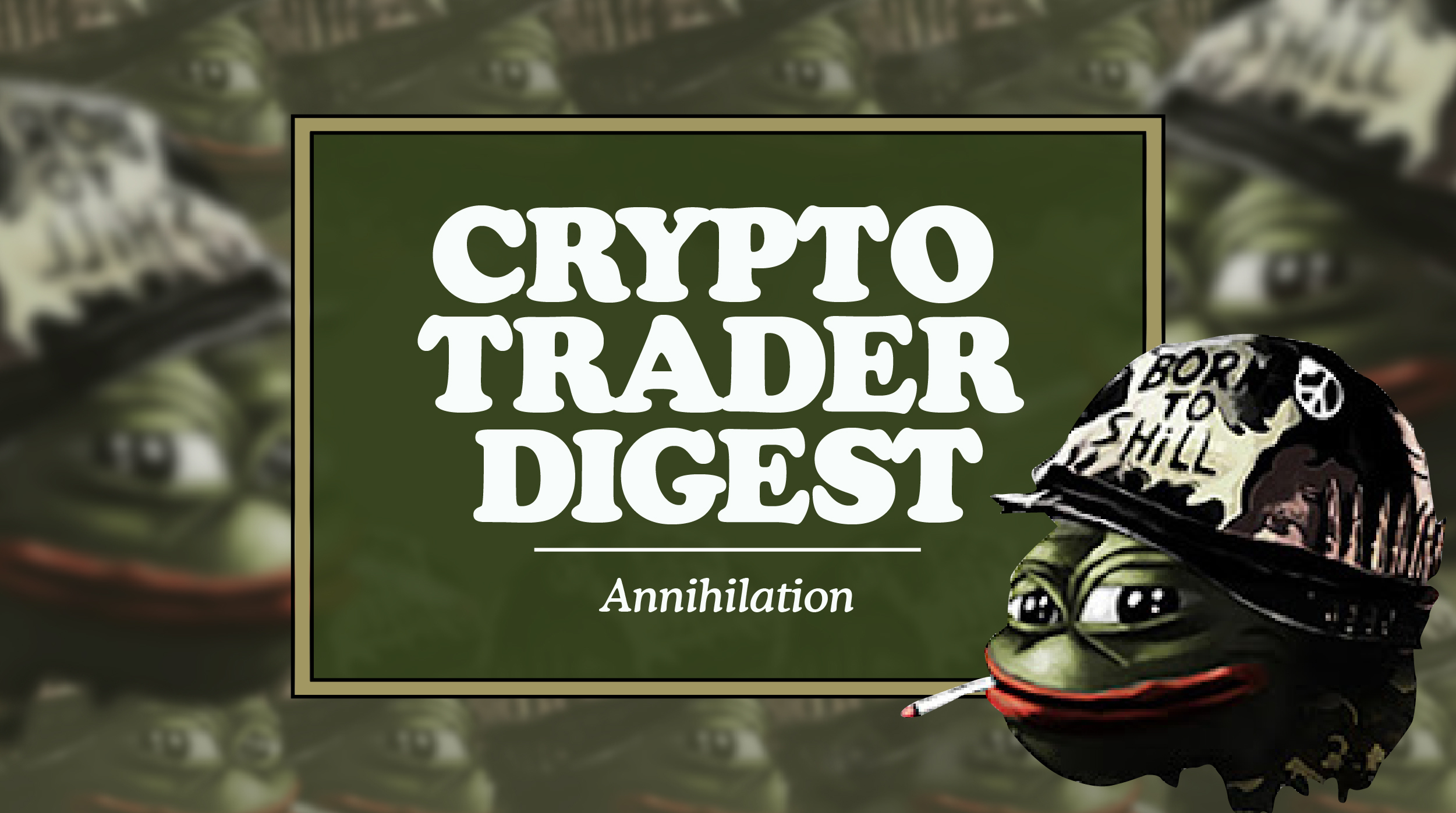
(Any views expressed in the below are the personal views of the author and should not form the basis for making investment decisions, nor be construed as a recommendation or advice to engage in investment transactions.)
Thankfully, unlike many others around the world, my experiences of war are sanitised and indirect. Two of my mother’s brothers were conscripted into the Vietnam War. One uncle decided fighting in the steamy hot Vietnamese jungles was not his idea of a good way to spend a portion of his youth, and was imprisoned for not fighting. Another went, and when I asked him what it was like, he said he felt like two angels were there protecting him from getting maimed or killed by enemy fire. My father fought in the Korean War, but he never talked much about his experiences, so I don’t have any idea on what he thought about the topic.
As a child growing up, my knowledge of war came from the television. The video game of war played out on nightly news broadcasts. Americans fighting in Iraq, Bosnia, Afghanistan, Iraq again and various other proxy skirmishes dotted the news casts. Luckily I did not suffer rationing of food or consumer items, or experience the effect of crushing inflation during the times America was at war.
Many in the world, likely including some of you readers, have experienced real hardship as a result of war. Family members you loved were injured or killed. You might be a refugee displaced by conflict. Or you have gone hungry because food was scarce or extremely expensive so that the soldiers could eat.
When viewed from a macro humanist perspective, war is always destructive and energy wasteful. Human civilization converts the potential energy of the sun and the earth into food, shelter, and entertainment. War is the act of spending energy to destroy the fruits of human civilization. While one side “wins”, and achieves some political or resource-driven goal by defeating their enemy, humanity loses because the things destroyed by kinetic energy weapons must now be rebuilt using additional energy. The potential contributions of the humans slain on both sides are also lost forever.
Because this is an essay that covers the crypto capital markets, we must consider humanity as a whole. Our currencies and assets are for the benefit of everyone, not just one particular imaginary construct that is a “nation”. There is no righteous war at a systemic level. Forget what the media on either side tells you about the justification for why this war is good for some nation state. Rather, consider that every life lost and structure damaged took energy to rear and construct. That energy is not inexhaustible, that is waste. The more we waste, the more negative consequences will be visited upon humanity as a whole. And the most obvious outcropping is inflation.
The war effort always crowds out the ordinary consumer. In order to supply the armed forces, production must be shifted away from satisfying the needs of the ordinary consumer to satisfying the needs of the military. The side that musters the most resources and energy with the least impact to the everyday life of their citizens is the side that usually prevails.
Many of you have probably studied various aspects of WWII in extreme detail. Your country may have even been created in the aftermath when the winning Allies carved up the world into spheres of influence that are still present today. Germany and Russia started as allies. Hitler needed the oil and grain of Stalin’s Soviet Union in order to power the war effort and feed ordinary Germans. However, Hitler needed more and more energy as the war went on, and he erroneously believed that if he invaded Russia he could easily capture Ukraine – the breadbasket of Europe – and the Caucasus oil fields.
Obviously, like Napoleon, he failed; Hitler invaded Russia and total exports of grain and oil from the USSR plummeted. Hitler would have been better off continuing to trade on fair terms with the USSR than invading it. As the war dragged on, morale in Germany declined in the face of food rationing and crushing inflation.
I only mention that vignette to illustrate that it usually is a net energy loss to take something via war, rather than trade. So anyone who believes war on a systemic macro level solves any of humanity’s problems, probably never watched their child go hungry so that a soldier in a far-off land can fight.
As we enter a period where the global order of flag-waving nations shifts and the probability of possible conflagrations rise, the prospect of persistent global inflation caused by military needs crowding out civilian ones is here. Now, putting aside the misery and suffering that war visits upon humanity, what should we do with our portfolios? I don’t mean to diminish the sorrow of war by immediately switching to commercial concerns – but we must prepare ourselves and our financial assets in an attempt to maintain a certain lifestyle vis-à-vis our personal and familial energy consumption.
Charge from Behind
The spectre of global conflict exists against a backdrop of the most accommodative monetary policy ever. I know that every major central bank talks about rising inflation and their commitment to dealing with it, but almost every major central bank is still printing money. Let’s observe some charts that depict policy rates vs. official measures of inflation. “Official” measures of inflation can never completely represent the prices an ordinary citizen faces. I believe these are massaged statistics that paint the best possible picture. Real consumer price inflation is acutely worse. But even the official statistics are a complete disaster.
Fed Funds – US CPI = US Real Interest Rate (Currently Negative 7%)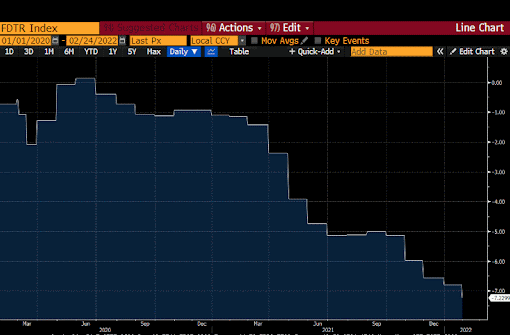
Euro Area Deposit Rate – Euro Area CPI = Euro Area Real Interest Rate (Currently Negative 5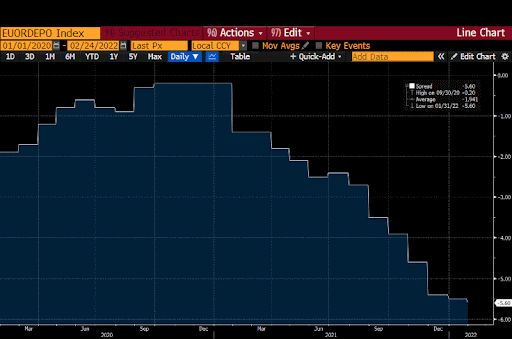
UK Bank Rate – UK CPI = UK Real Interest Rate (Currently Negative 5%)
The three charts above display the [Policy Rate – Official Consumer Price Inflation]. As you can see, real rates have become deeply negative since the start of the pandemic. Imagine you hold one dollar, euro, or pound in your wallet. Next year, that piece of fiat is suddenly worth 5% to 7% less. If workers’ wages rose by that amount, then that wouldn’t be an issue. But for most salaried or hourly workers, their wages are not rising at the pace of the destruction of the currency in their physical or digital wallet.
As you can imagine, the average Zhou, Jane, Johny, Jaewon, Jesus, et al. aren’t too happy that their wages are not keeping pace with prices of food, energy, and transportation. The politicians are now instructing their “independent” central banks to tame inflation. Central banks must now raise policy rates – that bit is not controversial. What is controversial is how much they decide to raise rates by and how quickly they want to accomplish it.
The entire financial world paints an apocalyptic picture should the Fed raise rates six times this year. That is what the Fed funds futures markets predict. If they raise rates by 0.25% six times, that would leave them with a policy rate of 1.5%. Even if the 7%+ US CPI inflation rate halved by year end, that would still leave real rates at negative 2%.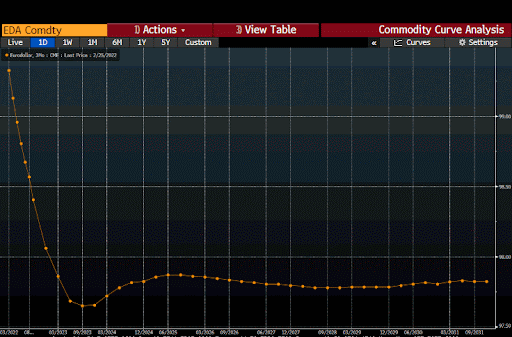
The above is a chart of the Eurodollar futures contract term structure. To arrive at the yield of US dollar deposits held outside of America, take 100 and subtract the futures price. For example, if the Eurodollar futures price is 98.00, then the yield is 2%.
I could write many thousand word essays on the importance of the Eurodollar market, but the TL;DR is that it is the most important interest rate market globally. This market is heavily influenced by Fed policy.
If we look at the Eurodollar futures curve, it tops out close to 2.5% in September of next year. The market expects the Fed to raise short-term rates, as the underlying for these futures are three-month USD deposit rates. 2.5% is not enough to combat the current levels of inflation, and that’s without factoring in various medium- or large-sized conflicts that will completely distort energy usage globally over the next 12 months.
The politicians gave a directive – “fix inflation”. The central bankers will comply, but only to a certain degree. Why? Because the level of nominal policy rates that is likely to cause a financial crisis creeps lower and lower each recession.
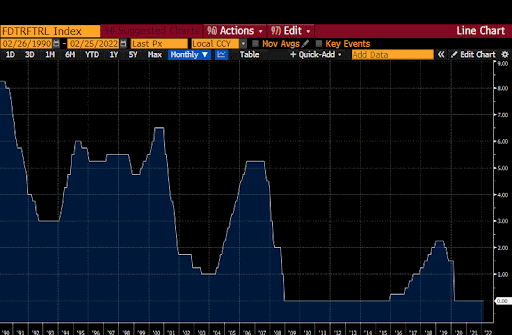
The above is a chart of the lower bound of the Fed funds rate since 1990. Every major global financial hiccup or crisis occurs because leverage and debt builds up in some area of the financial market. When the Fed raises rates, it pricks the bubble, as it becomes more expensive to finance folly.
Coming off of the low rates that followed the first Gulf War with Iraq, the Fed raised rates roughly 5% to 6% by the end of 1994. That resulted in the Mexican Peso crisis,and the US Treasury stepped in to bail out American lenders in Mexico. The Fed also pitched in by lowering rates a tad. A few years later, when rates rose to nearly 6%, the Asia financial crisis occurred. Various “Asian Tigers” came to the IMF and World Bank cap in hand asking for bailouts of their economies due to increased dollar funding costs.
We all know what happened to tech in 2000. The chart clearly shows that the Fed raised rates again after dropping them slightly in the aftermath of the Asian financial crisis. Higher funding costs diminished the hopes and dreams of a techno utopia, and a general equity market crash ensued.
Then the 9/11 attacks occurred and the Fed dropped rates and blew a housing bubble. Rates sky-rocketed by a massive 5% subsequently, and that ended up being the top of the US housing market in 2006. Voila– by 2008, losses stemming from toxic subprime mortgage derivatives infected the entire global financial system and bing bada boom!
After another seven years of 0% interest rates the Fed got the religion again, and started raising rates to slightly over 2% up until late 2018/early 2019. After rates went up, a general recession began in late 2019 plus the addition of the global pandemic, metastasized into one of the sharpest contractions of economic activity ever.
6%, then 5%, then 2% — every decade, the level at which the financial markets buckle under positive and rising nominal rates declines. Given that systemic debt and leverage exploded globally after COVID due to low to negative rates and a need to generate yield, I don’t think the global financial markets can handle nominal rates even at 2%.
Looking at the charts above, the major central banks are so far behind inflation that at a policy rate of 2%, rates are still negative. And unless workers start getting larger pay raises, they will still lose out month after month to the pernicious effects of consumer price inflation. That is a recipe for “social re-organisation”, let’s resurrect the Jacobins.
Inflation Narrative
Every asset class has an ever-shifting narrative around whether or not it will make a good hedge against inflation. Instinctively, many believe that as a scarce asset, Bitcoin and other cryptos are great inflation hedges. And over a multi-year time horizon, they are likely right. However, lately, Bitcoin has behaved in a more “risk-on / risk-off” fashion rather than an asset that always appreciates if real rates are negative.
Bitcoin obviously benefited to a large degree from the COVID-inspired global central bank money-printing bacchanal. It still needs to digest that massive move higher, and it doesn’t help that liquidity conditions are tightening. But, let’s remove negative rates from the picture for a moment.
Bitcoin rose from $4,500 in March 2020 to close to $70,000 in November of 2021. But then central banks changed their tune – saying that they would do the right thang and tame inflation. Just those comments were enough to pump short-end rates, and the crypto bull market stalled.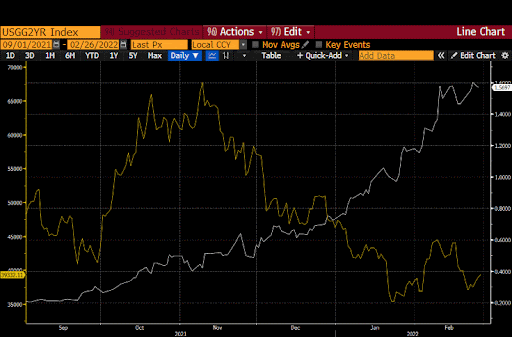
The chart above shows Bitcoin (the yellow line) vs. the 2-year US Treasury note (the white line) since September of 2021. In my view, the Bitcoin bull market stalled because liquidity conditions tightened globally. The market repriced fiat credit due to the expectation that central banks would raise nominal rates in the future, and it caused the 2-year yield to pamp 8x – sending Bitcoin sideways to slightly lower.
Gold, however, finally began stirring in its grave. It began marching higher towards $2,000 as rates persisted in negative territory. Short-end nominal rates rose, and gold still rose because real rates were still negative. As a result, gold’s historic tendency to hold value against a depreciating fiat regime has recently regained mindshare with investors. I expect Bitcoin will experience a similar narrative rediscovery eventually. Eventually is the key word, though – patience and the ability to tame your itchy buy-button finger is required to properly time a re-entry into or re-allocation of assets in the space.
Add a War
Let’s look at some possible scenarios that could occur if the current situation in Eastern Europe expands into a medium- or large-scale global conflict.
The starting point:
- Many countries decided to underinvest in the production of and exploration for hydrocarbons due to environmental concerns. That has led to society replacing cheap hydrocarbons with relatively expensive wind and solar (as measured by the energy each produces vs. the energy investment each requires). As a result, people are paying more for everything, because existing as a human in our current societal structure requires energy. Some might say the cost of hydrocarbons does not fully reflect their negative environmental externalities – but tell that to a family who now pays 50% more to heat their home during the dead of winter.
- The world printed the most money in human history over the last 50 years. Now that populations are getting older on average in all major economies, there will be less productive people to service an ever-growing mountain of debt. But to keep the game going, central banks must print money so that, on a nominal fiat basis, the old debt can be honoured. A government never voluntarily defaults on its obligations in its own currency – it uses inflation instead.
- Following past pandemics, inflation rises. Labour, which is scarcer, typically gains an upper hand over capital and demands a larger piece of the action. The post-COVID is no different. Costs are rising globally, as the productive workers who are left demand better wages and benefits. The robots aren’t ready yet, so companies still need all those “essential” workers.
- Central banks in the most developed economies need to raise rates substantially just to get to positive real rates. However, the nominal interest rate level at which the financial system is likely to collapse is at an all-time low. Some sectors of the financial and possibly real economy may implode if rates rise another 1% to 2% from current levels.
War is usually a conflict over resources or access to markets. It starts with either “I want your energy stores,” or “I want you to let me sell you things.” The ideological “ism” is just a cover for the economic reality of why one flag attacks another. As mentioned at the outset, systemically humanity never net benefits from the conflict. Therefore, the act of one flag acquiring another’s resources or markets leads to a general level of rising prices, all else being equal.
If you ever played the game Risk, read Brzezinski’s “Grand Chessboard”, or Mackinder’s “The Geographical Pivot of History”, it becomes abundantly clear that mastery of the Eurasian landmass is mastery of the world. This landmass holds the largest human population, and a significant percentage of the world’s natural resources like energy and metals.
If we as a global society can’t agree harmoniously on an equitable way to share these resources– and we never have– wars between flags are inevitable. There are periods of relative deceptive calm, but we are now past that. Any disruption to the flow of energy from this region will pour napalm on an already precarious situation. Energy will not get any cheaper as war persists. The fear of war alone disrupts trade, and entities hoard energy, and trade on more unfavourable terms.
Back to the monetary, what is a central banker when the same politicians who asked them to tame inflation are rattling war sabres?
Scenario 1: Tame Inflation
To properly tame inflation, central banks must at a minimum get to 0% real rates. That would require policy rates in the 6%+ territory – which seems unfathomable given the current state of the financial markets. But, that is the minimum necessary rate level necessary to even put a dent in inflation and rectify all the imbalances over the last 50 years.
And remember that a large part of current energy inflation is not a monetary phenomenon. It is due to chronic underinvestment in the cheapest forms of energy, and war. These are two problems the central bank cannot solve. Therefore, they might raise, raise, and raise rates again, without energy prices ever subsiding and then energy prices could suddenly decrease once the global economy collapses and there are much lower energy needs per capita because we have drastically reduced our consumption patterns.
2008 is kindergarten compared to the destruction of the global economy that would occur should rates rise to a 5% or 6% level. This sort of reset would flush many uneconomic businesses down the drain, and put humanity on a more sustainable growth trajectory. However, this sort of rebalancing is socially destabilising – especially for financial asset holders who make all the policies.
If real rates go to flat and then drastically positive in order to crush the world economy enough so that energy usage declines, there will be nowhere to hide financially besides volatility hedges – not even crypto – will save you. I continue to add exposure to my favourite vol hedge fund manager. Thankfully banks still sell them mispriced FX and interest rate options.
This is a scenario I do not think is very likely.
Scenario 2: Misdirection
This is my base case for most of 2022.
Central bankers appear in the financial media and tell the politicians they are serious about fighting inflation. The bankers raise policy rates into the 1% to 2% range – the futures markets tell us to do this and nothing else. At these levels, real rates are still massively negative, which is very important in a war or near-war time. That is because the government needs to spend money to fight or prepare to fight, and citizens don’t take kindly to outright taxes to pay for a war effort. Governments always resort to the surreptitious tax of inflation.
By keeping real rates negative and nominal government bond rates below the nominal GDP growth, a government can finance itself affordably and reduce its debt/GDP ratio. Negative real rates are sneaky, stealthy wealth transfers from savers to governments.
This level of nominal policy rate will result in a recession – but it won’t dramatically alter the fabric of society, and the government can still finance its war effort affordably.
The one issue is that, once again, the central banks are not in control of the cost of energy, which is likely to continue getting more expensive. And because their monetary policy is still accommodative to government spending, the government will still crowd out the private sector with respect to energy usage. Therefore, there is a risk that the lack of inflation-fighting conviction leads to social unrest, as the cost of energy continues to rise because monetary policy is still too accommodative.
As it pertains to our portfolios, patience is key. If the Fed and other central banks raise rates, it will crush asset prices, but Bitcoin and crypto will emerge from the carnage first. The crypto markets are the only freely tradable markets in which all of humanity with an internet connection can participate. Therefore, crypto markets will go down and up first vs. the rest of the TradFi markets. Remember, real rates will still be negative. Once persistent negative real rates bites into the purchasing power of fiat, the stampede into scarce assets will be glorious. Wealth on USB sticks and pet shiny gold colour inert rocks sitting in a vault will feel beaucoup love.
Central banks do not want to re-organise society by raising rates enough to actually curb consumer desires and government spending. The political pressure to fight inflation disappears once elections are concluded.
For us crypto traders, it requires patience. If you are already in what you consider your benchmark crypto assets (mine are Bitcoin and Ether), stay there. Don’t go short vs. your ideal allocation – kick back in your Corbusier eames lounge chair, crack open a bottle of low intervention vino, read a book (no TikTok), and chill. If you are an engaged day trader, then remember the dip and the narrative shift to inflation-protecting assets will occur at lightspeed. Currently, it’s slow motion for ya – the meandering sideways crawl before the action. So don’t be greedy –, get in, get out, and get long.
Update!!!
I wrote this piece over the weekend when it appeared that the current Russia-Ukraine conflict would be short and the Western response muted. However, the war continues, and it appears the West is prepared to endure economic pain in order to decouple from Russia. Russia (and whatever territory is considered Ukraine in the future) is a major supplier of food and energy. Removal of these supplies from the global market is highly inflationary.
Also there is no way to actually know for sure what the financial consequences will be should a decoupling occur. You never know where all the cockroaches are hiding on financial institutions’ balance sheets until you shine the light of market volatility. Therefore, the assumption should be that a decoupling will result in financial distress at a few large financial institutions. That distress could transform into a globalised financial crisis given the large amounts of leverage embedded in the system.
The political response of the West to Russia cracks open an opportunity for the global central banks to walk away from their pledge to fight inflation. I am not certain that they will be able to politically do that because again inflation will only go up as the world attempts to remove Russian energy from the mix. Therefore, I am turning cautiously bullish on Bitcoin. I am dipping my toes into some very out of the money call options on Bitcoin and Ether. I’m probably over trading a bit, but I just love markets.
The March Fed Funds futures indicates the market believes the Fed will raise rates 0.25%. However, watch closely the rhetoric from favourite Fed mouth pieces at large investment banks and the opinion columns of the Wall Street Journal. The Fed will float trial balloons on the subject of whether the potential or actual market turmoil due to the current conflict is severe enough to warrant more “accommodative” (euphemism for Print Dat Money). Depending on the market and political response, they may believe politically they can continue with 0% rates.
To be clear, I am not ready to back up my gas guzzling G-Wagon and onboard more crypto exposure. This is cautious buying in the face of changing circumstances. The central banking mandarins will provide a clear “all aboard” signal to the inflation crypto magic carpet. The first signpost is if the Fed deviates from the market expected 0.25% to 0.50% raise in policy rates in mid-March. My base case still remains that a flush out of financial leverage that takes crypto down with it one more time will occur before we can scream higher.
Scenario 3: Money Printer go Brrr
A hot kinetic global conflict is a complete game changer. Inflation becomes the name of the game, because the political necessity shifts from “let’s fight inflation so that the middle class preserves economic dignity” to “that flag over there is evil and must be defeated, so do your duty, citizens, by enduring this inflation to win the war”.
Price controls, rationing, and inflation will be the new normal in various countries so that all available resources are given to the military. Domestic currencies will be spent as quickly as they are earned. Gold, Bitcoin, and other cryptos will be hoarded. It will be Gresham’s law in action. Access to gold and crypto markets will become more difficult because capital controls will limit the ability of ordinary citizens to protect themselves against the theft of inflation.
In real terms, most fiat-denominated financial assets will be less valuable than toilet paper. Yes, your stock portfolio might go up in nominal terms, but the price of milk, butter, eggs, sugar etc. will rise faster than your no-cost equity index fund.
I sincerely hope that this does not come to pass. You read about the quotidian experience of citizens during the world wars, and it was various degrees of unpleasantness depending on which flag’s borders you resided. But reading a book and living it are two different experiences. I don’t want to get that sort of experience. But the history of humanity is unfortunately the history of conflict.
Even though I’m hopeful that it’s only a remote possibility, if you believe this scenario is at all likely to occur, it behoves you to trade way ahead of it. That means taking spare financial assets and buying portable stores of wealth that are globally recognized. Domestic assets, e.g., real estate and equities, will not keep value in real terms. Gold, Bitcoin, and some other cryptos will retain global value vs. energy.
At some point the conflict ends, and hopefully your “savings” aren’t in a piece of fiction that had value pre- but not post-war. No portion of society ever escapes war unscathed financially – the best you can do is to protect what you can before you think it’s necessary. If you don’t believe that, watch Downton Abbey again. The great families of Britain had to hawk their family “birthrights” because the crushing inflation and economic costs of war left the country broke. The political response was taxes on those who had still had assets nailed to the ground.
Naiveté
The global citizenry now possesses smartphones that fit inside their pocket, which are a tool of mass communication to share knowledge instantaneously. We can show each other the depravity and destruction war ravages upon our respective societies. Hopefully the knowledge of what bombs and bullets can do, in real time and in colour, tempers the collective from going along with wars put in front of them by the political elite.
But while we can all be idealistic and hope that the proliferation of information can change humanity’s proclivity for waging war on itself, we must prepare our finances to survive the scourge of inflation. That isn’t to say we should disregard the short-term price action, which I believe is negative for risk assets. The trick is to recognize when it’s time to pay the offer, at whatever the price – because he who sells fiat first, sells fiat best.
